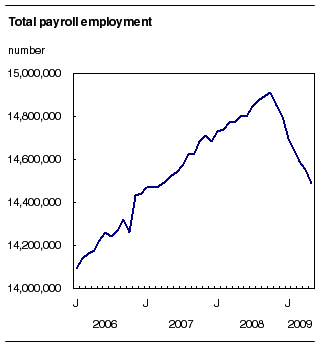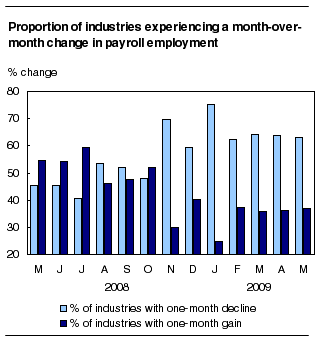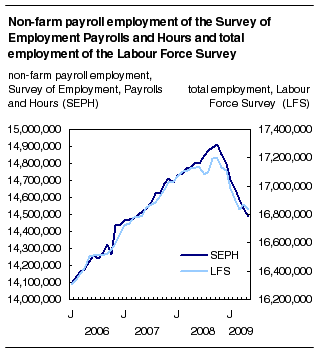Common menu bar links
Payroll employment, earnings and hours
Archived Content
Information identified as archived is provided for reference, research or recordkeeping purposes. It is not subject to the Government of Canada Web Standards and has not been altered or updated since it was archived. Please "contact us" to request a format other than those available.
Total non-farm payroll employment fell by 64,000 in May, down 0.4% from April, bringing total losses to 423,900 since the peak in October 2008. The proportion of industries experiencing job losses edged down in May to 63%.

These data come from the Survey of Employment, Payrolls and Hours (SEPH). SEPH is a business survey that provides a detailed portrait of employees from an industry perspective, complementing information on total employment from the Labour Force Survey (LFS), which is a survey from a household perspective.
In May, 192 of the 305 (63%) industries covered by the survey experienced declines. During this current economic downturn, the highest proportion of industries shedding jobs was in January, at 75%.
Payroll employment fell in both the goods and service sectors in May, with the largest declines in motor vehicle manufacturing; elementary and secondary education; motor vehicle parts manufacturing; and full-service restaurants.
Ontario, Quebec and British Columbia experienced the largest losses in payroll employment in May. Declines were also observed in Alberta, New Brunswick, Newfoundland and Labrador and Nova Scotia.
The number of employees rose in Manitoba, Prince Edward Island and Saskatchewan.

In May, the average weekly earnings of payroll employees, including overtime, was $820.38, up 1.6% from May 2008. This year-over-year increase was faster than the growth in average weekly earnings of 1.1% observed between April 2008 and April 2009, but was considerably slower than the most recent year-over-year peak increase of 3.0% in October 2008.
Note to readers
Unless otherwise specified, data in this release refer to payroll employment and earnings data obtained from the Survey of Employment, Payrolls and Hours (SEPH).
Each month, Statistics Canada now provides enhanced analysis of the current labour market situation, using data from SEPH and other sources. The Labour Force Survey (LFS) will provide the first picture of overall labour market conditions, including unemployment, total employment and those affected by changes in the labour market. Later in the month, Statistics Canada will provide additional detail by industry through the SEPH Daily release, and regional detail through the Employment Insurance statistics.
With the release of January 2009 SEPH data on March 31, 2009, an improved estimation method for earnings and hours data was introduced and estimates back to 2001 were revised to ensure continuity in the data series.
Weekly earnings down in manufacturing
Between May 2008 and May 2009, average weekly earnings in Canada's largest industrial sectors were up 8.6% in health care and social assistance, 3.9% in retail trade, 2.4% in accommodation and food services, and 1.3% in public administration.
At the same time, average weekly earnings fell 6.1% in manufacturing and 1.9% in educational services.
Average weekly earnings posted year-over-year increases in 9 of the 10 provinces in May. The fastest growth occurred in Alberta (+5.5%), followed by Newfoundland and Labrador (+4.9%). In Quebec, average weekly wages dropped 0.8% in May from a year earlier.
Growth in national average weekly wages has been consistenly lower in the months following October 2008, when payroll employment reached its peak.
Education, accommodation and food services drive losses in service sector
In May, the number of employees working in educational services fell by 10,600, driven by losses in elementary and secondary schools (-4,100), universities (-2,500) and community colleges and CEGEPs (-1,900).
There were also declines in accommodation and food services in May, with losses in full-service eating places (-3,500) and traveller accommodation (-2,900).
At the same time, scheduled air transportation, which includes freight and passenger flights, experienced a drop of 3,200 in the number of employees. This coincided with a decline in international plane trips to and from Canada in May. However, payroll employment in this industry has remained little changed since October 2008, with gains since then offset by losses in April and May.
Since October, one of the industries with the largest declines in payroll employment has been construction (-66,100). With the general decline in construction activity, there has been an associated decrease in payroll employment in architectural, engineering and related services, down 2,800 in May. Since the peak in October 2008, architectural, engineering and related services has shed 16,300 jobs, a decline of 8.7%.
The number of employees in general freight trucking also continued its downward trend, falling 2,200 in May. Since October 2008, this industry's payroll employment has contracted by 7.4%, or 7,600 jobs.
In spite of these service-sector losses, there were also a number of industries that experienced growth. Some of the largest increases in the number of employees occurred in other provincial and territorial public administration (+3,000), general medical and surgical hospitals (+2,800), and other amusement and recreation industries (+2,100), which include golf courses, marinas, and fitness and recreational sports centres.
Motor vehicle manufacturing suffers more losses
The number of employees working in manufacturing fell by 25,100 in May, pushed down by losses in motor vehicle manufacturing (-4,800) and motor vehicle parts manufacturing (-3,700). Among other manufacturing industries experiencing declines were iron and steel mills (-1,600), printing and related support activities (-1,500), bakeries and tortilla manufacturing (-1,500), as well as plastic product manufacturing (-1,300).
In spite of these losses, there were pockets of growth within the manufacturing sector in May, with dairy product manufacturing as well as grain and oilseed milling posting respective increases of 1,500 and 1,300.
Elsewhere in the goods sector, payroll employment continued to fall in support activities for mining, oil and gas (-3,200) in May. Since the start of the economic downturn, this industry has shed 23,000 jobs, a decline of 25.3%. Payroll employment in mining and quarrying has also been on a downward trend since October 2008, falling 11.2%.
Oil and gas extraction, however, has seen its payroll employment rise 2,100, or 3.8%, since January 2009.
The number of employees working for building equipment contractors declined by 2,100 in May, bringing total losses since October to 13,300 (-6.0%). In conjunction with losses in a number of other construction industries, payroll employment in the broader construction sector has declined by 66,100, or 7.8%.
Comparing SEPH and LFS
Data on employment, wages and hours worked are produced by two major Statistics Canada monthly surveys: LFS and SEPH. Survey estimates differ for conceptual reasons and for methodological reasons. The information source is the key distinction between the two surveys: SEPH provides information related to occupied jobs based on a census of administrative data from businesses, whereas LFS provides information on the employment characteristics of individuals based on a survey of households. While the estimates from the survey do differ, the trends in the data are quite similar.

Since each of these surveys addresses different needs, the choice of data depends on the users' goals. Other conceptual and methodological differences between the two surveys include the degree of coverage of industries and the self employed; the treatment of multiple-job holders; and the survey reference period. The effects of these differences vary by industry.
Available on CANSIM: tables 281-0023 to 281-0039 and 281-0041 to 281-0046.
Definitions, data sources and methods: survey number 2612.
Detailed industry data, data by size of enterprise based on employment, and other labour market indicators will be available soon in the monthly publication Employment, Earnings and Hours (72-002-X, free).
Data on payroll employment, earnings and hours for June will be released on August 28.
For more information, or to order data, contact Client Services (toll-free 1-866-873-8788; 613-951-4090; labour@statcan.gc.ca). To enquire about the revisions, concepts, methods or data quality of this release, contact Danielle Zietsma (613-951-4243), Labour Statistics Division.
Table 1
| Industry group (North American Industry Classificiation System) | December 2008 | May 2008 | April 2009r | May 2009p | April to May 2009 | May 2008 to May 2009 | December 2008 to May 2009 |
|---|---|---|---|---|---|---|---|
| Seasonally adjusted | |||||||
| thousands | % change | ||||||
| Industrial aggregate | 14,800.4 | 14,804.8 | 14,554.0 | 14,490.0 | -0.4 | -2.1 | -2.1 |
| Forestry, logging and support | 44.7 | 47.5 | 37.7 | 37.6 | -0.3 | -20.8 | -15.9 |
| Mining and quarrying, and oil and gas extraction | 203.5 | 197.5 | 184.9 | 184.7 | -0.1 | -6.5 | -9.2 |
| Utilities | 122.7 | 118.4 | 120.6 | 119.0 | -1.3 | 0.5 | -3.0 |
| Construction | 817.7 | 831.4 | 783.6 | 781.7 | -0.2 | -6.0 | -4.4 |
| Manufacturing | 1,599.6 | 1,692.7 | 1,514.9 | 1,489.8 | -1.7 | -12.0 | -6.9 |
| Wholesale trade | 753.7 | 757.7 | 735.7 | 732.8 | -0.4 | -3.3 | -2.8 |
| Retail trade | 1,884.0 | 1,907.8 | 1,864.2 | 1,867.0 | 0.2 | -2.1 | -0.9 |
| Transportation and warehousing | 696.7 | 692.9 | 682.6 | 674.9 | -1.1 | -2.6 | -3.1 |
| Information and cultural industries | 326.3 | 324.2 | 325.4 | 323.4 | -0.6 | -0.2 | -0.9 |
| Finance and insurance | 666.4 | 650.1 | 664.0 | 663.0 | -0.2 | 2.0 | -0.5 |
| Real estate and rental and leasing | 246.8 | 253.8 | 241.7 | 239.7 | -0.8 | -5.6 | -2.9 |
| Professional, scientific and technical services | 766.6 | 748.3 | 746.8 | 740.4 | -0.9 | -1.1 | -3.4 |
| Management of companies and enterprises | 121.3 | 122.5 | 120.6 | 117.9 | -2.2 | -3.8 | -2.8 |
| Administrative and support, waste management and remediation services | 754.2 | 778.3 | 725.4 | 718.5 | -1.0 | -7.7 | -4.7 |
| Educational services | 1,147.5 | 1,138.2 | 1,149.7 | 1,139.2 | -0.9 | 0.1 | -0.7 |
| Health care and social assistance | 1,567.2 | 1,517.8 | 1,570.7 | 1,574.5 | 0.2 | 3.7 | 0.5 |
| Arts, entertainment and recreation | 242.1 | 236.1 | 245.9 | 248.5 | 1.1 | 5.3 | 2.6 |
| Accommodation and food services | 1,095.3 | 1,077.8 | 1,073.7 | 1,065.0 | -0.8 | -1.2 | -2.8 |
| Other services (excluding public administration) | 510.5 | 508.7 | 504.5 | 502.5 | -0.4 | -1.2 | -1.6 |
| Public administration | 1,024.4 | 998.0 | 1,029.4 | 1,032.1 | 0.3 | 3.4 | 0.8 |
| Provinces and territories | |||||||
| Newfoundland and Labrador | 192.4 | 190.3 | 194.0 | 191.8 | -1.1 | 0.8 | -0.3 |
| Prince Edward Island | 61.5 | 61.0 | 61.9 | 62.6 | 1.1 | 2.6 | 1.8 |
| Nova Scotia | 393.0 | 397.9 | 393.0 | 392.1 | -0.2 | -1.5 | -0.2 |
| New Brunswick | 311.0 | 312.9 | 309.5 | 306.7 | -0.9 | -2.0 | -1.4 |
| Quebec | 3,393.1 | 3,375.2 | 3,351.6 | 3,336.1 | -0.5 | -1.2 | -1.7 |
| Ontario | 5,671.0 | 5,712.3 | 5,568.3 | 5,546.9 | -0.4 | -2.9 | -2.2 |
| Manitoba | 562.8 | 561.2 | 555.5 | 557.1 | 0.3 | -0.7 | -1.0 |
| Saskatchewan | 439.9 | 434.0 | 440.3 | 440.9 | 0.1 | 1.6 | 0.2 |
| Alberta | 1,789.8 | 1,760.7 | 1,728.8 | 1,724.2 | -0.3 | -2.1 | -3.7 |
| British Columbia | 1,935.0 | 1,941.8 | 1,889.6 | 1,883.2 | -0.3 | -3.0 | -2.7 |
| Yukon | 19.5 | 19.8 | 19.4 | 19.2 | -1.0 | -3.0 | -1.5 |
| Northwest Territories¹ | 26.8 | 24.8 | 26.3 | 26.4 | 0.4 | 6.5 | -1.5 |
| Nunavut¹ | 10.1 | 10.5 | 9.9 | 10.1 | 2.0 | -3.8 | 0.0 |
Table 2
| Industry group (North American Industry Classificiation System) | May 2008 | April 2009r | May 2009p | April to May 2009 | May 2008 to May 2009 |
|---|---|---|---|---|---|
| Seasonally adjusted | |||||
| dollars | % change | ||||
| Industrial aggregate | 807.54 | 818.06 | 820.38 | 0.3 | 1.6 |
| Forestry, logging and support | 929.13 | 821.46 | 803.03 | -2.2 | -13.6 |
| Mining and quarrying, and oil and gas extraction | 1,527.65 | 1,625.47 | 1,650.24 | 1.5 | 8.0 |
| Utilities | 1,440.01 | 1,466.99 | 1,486.70 | 1.3 | 3.2 |
| Construction | 987.66 | 1,035.89 | 1,043.44 | 0.7 | 5.6 |
| Manufacturing | 961.83 | 904.03 | 903.43 | -0.1 | -6.1 |
| Wholesale trade | 940.06 | 959.99 | 980.42 | 2.1 | 4.3 |
| Retail trade | 472.71 | 479.51 | 491.26 | 2.5 | 3.9 |
| Transportation and warehousing | 887.73 | 894.12 | 882.31 | -1.3 | -0.6 |
| Information and cultural industries | 980.84 | 1,074.76 | 1,115.65 | 3.8 | 13.7 |
| Finance and insurance | 999.27 | 1,046.07 | 1,044.26 | -0.2 | 4.5 |
| Real estate and rental and leasing | 786.04 | 764.31 | 746.71 | -2.3 | -5.0 |
| Professional, scientific and technical services | 1,100.17 | 1,133.02 | 1,124.26 | -0.8 | 2.2 |
| Management of companies and enterprises | 1,105.32 | 1,094.89 | 1,110.99 | 1.5 | 0.5 |
| Administrative and support, waste management and remediation services | 664.43 | 686.76 | 648.22 | -5.6 | -2.4 |
| Educational services | 867.00 | 852.16 | 850.48 | -0.2 | -1.9 |
| Health care and social assistance | 725.11 | 778.28 | 787.47 | 1.2 | 8.6 |
| Arts, entertainment and recreation | 500.97 | 493.34 | 509.48 | 3.3 | 1.7 |
| Accommodation and food services | 329.51 | 331.08 | 337.46 | 1.9 | 2.4 |
| Other services (excluding public administration) | 675.77 | 682.09 | 688.88 | 1.0 | 1.9 |
| Public administration | 1,042.77 | 1,063.38 | 1,056.18 | -0.7 | 1.3 |
| Provinces and territories | |||||
| Newfoundland and Labrador | 762.48 | 795.80 | 800.09 | 0.5 | 4.9 |
| Prince Edward Island | 663.33 | 687.01 | 688.23 | 0.2 | 3.8 |
| Nova Scotia | 709.96 | 730.77 | 727.92 | -0.4 | 2.5 |
| New Brunswick | 726.10 | 738.86 | 749.60 | 1.5 | 3.2 |
| Quebec | 760.23 | 759.46 | 754.09 | -0.7 | -0.8 |
| Ontario | 835.84 | 846.50 | 846.69 | 0.0 | 1.3 |
| Manitoba | 752.57 | 761.32 | 766.36 | 0.7 | 1.8 |
| Saskatchewan | 777.82 | 790.46 | 806.66 | 2.0 | 3.7 |
| Alberta | 899.57 | 936.30 | 948.62 | 1.3 | 5.5 |
| British Columbia | 788.33 | 789.76 | 799.65 | 1.3 | 1.4 |
| Yukon | 847.75 | 889.99 | 909.26 | 2.2 | 7.3 |
| Northwest Territories¹ | 1,042.60 | 1,134.97 | 1,146.39 | 1.0 | 10.0 |
| Nunavut¹ | 893.38 | 858.29 | 885.79 | 3.2 | -0.8 |

